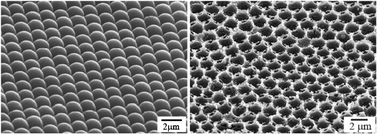Highly ordered, macropore arrays, that is, inverse opal structures, of Na2W4O13 were successfully synthesized by spray pyrolysis using polystyrene (PS) colloidal crystals as templates. A densely packed monolayer of monodisperse PS microspheres was deposited on a silica glass substrate by use of the Langmuir–Blodgett thin film technique. Subsequently, Na2W4O13 layers were deposited on the PS templates as a thin layer by spray pyrolysis of a 5(NH4)2O·12WO3·5H2O–NaCl solution. The PS templates were, finally, removed by thermal treatment, generating a surface with features (inverse opal structures) located where the interstitial space of the densely hexagonal-packed PS microspheres had been. The macroporous structures obviously depended on the annealing conditions such as time and temperature. The macropores were basically hemispherical in shape and highly honeycombed arrangement, which corresponded well to the PS templates. The inverse opal textures of Na2W4O13 layer surfaces enhanced their hydrophobicity. The surfaces modified by fluoroalkylsilane (FAS) were converted from hydrophobic (water contact angle = 127°) to hydrophilic (30°) by photocatalytic oxidation using the Na2W4O13 crystal layer. The Na2W4O13 crystals exhibited high activity for FAS photodegradation.

You have access to this article
 Please wait while we load your content...
Something went wrong. Try again?
Please wait while we load your content...
Something went wrong. Try again?


 Please wait while we load your content...
Please wait while we load your content...